Add "Inbox" to "All Messages"
-
Feature Request
Add Inbox filter/button under the All Messages group.
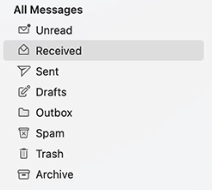
Background & Context
Good day,
I have been a long-time Vivaldi user (Since Opera). I am currently trialling Vivaldi Mail for business and private usage. If successful I will be introducing it to the rest of our company.
One major obstacle to us adopting Vivaldi Mail is the lack of an Inbox filter/button under the all Messages group.
Being able to see a user's Inbox on its own is vital to email management. I can see my Inbox per mailbox but if I manage multiple mailboxes I need to see my Inbox across all accounts.
I can see that the Inbox missing from all messages has created a lot of confusion amount many users when searching the forums as this is an expected norm for many email users.
I know Vivaldi is looking to promote a different way of managing email through labels and filters, but this should be on top of normal traditional email norms, not at the expense.
I tried to solve this with a filter but was unsuccessful as the filter feature has no support for IMAP folders, so I can't say show me all messages in "X" folder.
Currently, Vivaldi Mail supports all the standard folders under all messages, I don't understand why it can't also support Inbox.
If it goes against what Vivaldi is trying to promote make the "All Messages" configurable and allow users to enable it as needed.
Thanks.
-
@NaXsa welcome to the forum and thanks for taking your time testing out Vivaldi mail.
@NaXsa said in Add "Inbox" to "All Messages":
I need to see my Inbox across all accounts.
Depending on your workflow, the Unread or the Received view is your Inbox for all practical purposes, because they do exactly that: allowing you to see your emails in all inboxes from all accounts. These filters collect all received emails from all accounts into this one view, with Unread by standard settings only showing unread emails, whereas Received also shows read messages by default.
With the toggle buttons above the search field you can choose to have these filters show or hide emails that meet certain criteria, such as whether or not they are in custom imap folders, declared as mailing lists etc. Among these options I still miss a "filtered" toggle to hide messages that are in some custom filter but not moved to a special IMAP folder in some account.
I personally prefer to treat Unread as my Inbox, when I mark a message as read it's out of sight (equivalent to archived). Others may want to see their read emails and hence prefer to treat the Received view as their inbox. To clean that out, archive messages and Vivaldi will move it to the IMAP folder declared as archived - and if the archive toggle button is off in Received, those emails are out of sight.
@NaXsa said in Add "Inbox" to "All Messages":
the filter feature has no support for IMAP folders
True, this is missing from the mail actions. Vivaldi mail is fairly new, this might be added later down the road. Vote for this feature request https://forum.vivaldi.net/topic/74937/add-mail-filter-action-move-to-imap-folder
-
Thank you @WildEnte, I tried working through the filters you mentioned, and I was eventually able to come to a workaround.
I describe it as a workaround because it's not very intuitive. Because the default behaviour for everyday usage does not make much sense.
Unread and Received are by default across a user's entire mailbox and by default show everything with the only difference being the read/unread filter.
I would argue that very few users would want this default view/behaviour for Received. Let's look at archived as an example. If I wanted to view archived I would click on the archived folder that is very conveniently at the bottom of the same list.
All Messages vs Received
However, I think the biggest problem for me is that "Received" is actually a duplication of "All Messages", and the received filter item adds no value.
If "Received" were changed to be "Inbox" and behaved the same as "Sent" and "Archived", this would add functionality and nothing would be lost.
This would also cover the default expected behaviour of any user coming from any other mail client, and that is to see their Inbox, Sent items, Drafts, Deleted Items and Archive.
If a user still wanted to see all emails AKA "Received" they could click on the more accurately described "All Messages".
For me, this would meet the requirements of most if not all common user workflows, and reduce confusion among new users.
-
@NaXsa said in Add "Inbox" to "All Messages":
I think the biggest problem for me is that "Received" is actually a duplication of "All Messages",
All messages also shows sent messages, and that across all accounts - hence the name. Received only shows sent emails if they are in a thread with a received email AND threaded view is turned on. So no, it's not a duplication.
I don't recall other threads / questions about whether or not received should be renamed to "Inbox" - I don't have a valid opinion on this because in German the word inbox is usually translated to "Posteingang" or "Eingang", which is "incoming" and thus nicely covers bot Inbox and Received.
What makes an inbox a true inbox in your opinion, in terms of functionality?
-
@WildEnte said in Add "Inbox" to "All Messages":
What makes an inbox a true inbox in your opinion, in terms of functionality?
That is a very clever question to ask. Maybe I am assuming we are talking about the same thing when we might not be.
So if you would indulge me with some context and technical background before answering the question.
Context
If you log into any webmail client, you will almost always be presented with 5, sometimes 6 IMAP folders. Inbox, Drafts, Sent, Trash, Junk and Archive.
So an Inbox is a concrete concept in the IMAP RFC.
The Inbox folder, referred to by the name INBOX in the RFC has special meaning and is defined as "the primary mailbox for this user on this server".
The other folders are also defined in the RFC as they are trying to standardise these things.
The client is configured to save a copy of all mail sent by the user into a mailbox with the \Sent attribute (see Section 7.3.1). Furthermore, after a message is deleted from a mailbox, the client is configured to move that message to a mailbox with the \Trash attribute.
Now, backing up a bit and looking at it from a mail server's point of view. To a mail server, an IMAP mailbox is a collection of folders and each of these folders is referred to as a mailbox. With the INBOX being the primary place new emails are saved into.
Now you can see how this has shaped email clients and user norms regarding email. If you look at screenshots of Outlook, Thunderbird or the majority of email clients, including webmail clients. You will find an
Inboxthat maps directly to a specific location on the email server.These concepts also have a historical background in physical mail and human behaviour. Before email buildings would have mail rooms (similar to an MTA) where new emails would arrive and then be delivered to a tray often referred to as an inbox that would sit on a person's desk. We can see this concept often portrayed in inbox icons with an arrow pointing into a tray.
Answer
So to answer your question, what is an Inbox to me? To me, my inbox is the primary IMAP folder in which new emails arrive. New emails will never arrive anywhere else, only in the Inbox IMAP folder.
Now I know email from a client's point of view can be done in many ways. With that said based on my experience, for many people, their Inbox is the most important email folder because that is their current working progress. This can include read or unread emails.
Now, in my opinion, the current setup with Vivaldi Mail does not cater for the most important IMAP folder in the RFC and is the most common use case for email management and email norms.
To reproduce the same thing requires using a combination of filters and user's changing behaviours that for many, goes back decades.
It does not matter if you talking about physical postage or digital emails, they both only have one place new stuff arrives. Whether it's a postbox, PO box or inbox, it's the same concept.
So if you want to make the distinction of received being different from all messages. That's fine, I am not going to argue that, but please give me direct access to my inbox across all email addresses.
Concrete Pictures
I have individual access to all my inboxes, but I can only view them one at a time.
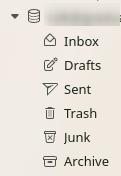
Why does the all message list all the IMAP folders except
Inbox?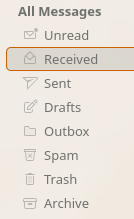
-
@NaXsa Thanks for elaborating. To me it seems that Received is pretty exactly like a unified inbox, giving you a little more control with the toggle buttons. It collects all emails from all inbox IMAP folders from all accounts, only hiding emails marked as spam (and trash) by default.
Whether or not Vivaldi should rename "Received" into "Inbox" ... I don't know. What's in a name?

-
@WildEnte I am not sure we are in agreement with your definition of receiving and a unified inbox. The problem is that receiving is across all folders, not just the Inbox folders. It's all emails I have ever received, regardless if those emails have been moved into a different custom IMAP folder or been archived.
The inbox I am looking for should behave the same as the other standard folders under all messages. IE: Sent, Drafts, Outbox ...
I don't understand why Inbox has been excluded from this behaviour.
This is the same if you manage multiple email accounts using Google Gmail and you enable their unified inbox. Described in the settings as the "Inbox type" setting being set to "Multiple Inboxes".
So a unified inbox means all messages in the Inbox IMAP folder for all accounts, not all messages ever received across almost everything.
I think a screenshot from Mailspring visual illustrates it best. Another email client I am reviewing.
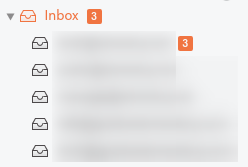
Once an email has been moved out of my Inbox. And I am using the term Inbox to mean the IMAP folder on my mail server. It has been dealt with and has been archived/filed/stored.
I don't need to see that email again unless for a very specific reason, whereby I will go look it up in the location it was stored.
Also when using the word "I", this includes several people that I am evaluating Vivaldi Mail on behalf of at our company. I am hoping to make our default browser and mail client Vivaldi. Unfortunately, this Inbox issue seems to be becoming a bit of a deal breaker.
Thanks for listening.
-
@NaXsa Vivaldi does not give you the option to show the folders like you would like to see it, so don't take my comments as "what you want is wrong" (preference cannot be argued), I try to point out how to get as close as possible with the means Vivaldi gives you.
That being said, I think the difference is not that big, having used plenty of email clients in my time..
@NaXsa said in Add "Inbox" to "All Messages":
Once an email has been moved out of my Inbox. And I am using the term Inbox to mean the IMAP folder on my mail server
Use the toggle button for showing / hiding custom imap folders in received. Moving mails to other folders is not too convenient in Vivaldi (no drag and drop)
@NaXsa said in Add "Inbox" to "All Messages":
I don't need to see that email again unless for a very specific reason, whereby I will go look it up in the location it was stored.
In Vivaldi you just stay in received, toggle the custom imap folder button and search. (or go to that imap folder. I'm not a fan of folders, see my signature)
-
@WildEnte said in Add "Inbox" to "All Messages":
so don't take my comments as "what you want is wrong" (preference cannot be argued)
No offence taken. I enjoyed this discussion. It helped me better understand and define our use case, and instead of dismissing my use case, you have asked questions to try and understand.
@WildEnte said in Add "Inbox" to "All Messages":
That being said, I think the difference is not that big
This is where I have to disagree. As an exercise, I put Vivaldi Mail in front of a user and the very first question I was asked was "where is my inbox". They then scrolled down to find the All account section and then asked for that to be moved to the top and to make "All Messages" go away.
I showed them they could get to a similar point using received but they were not interested because they wanted direct easy access to their Inbox. This was a user with one mailbox.
Users with multiple mailboxes want easy access to a unified Inbox as I described before without needing to mess with filters.
@WildEnte said in Add "Inbox" to "All Messages":
Moving mails to other folders is not too convenient in Vivaldi (no drag and drop)
Correct, IMAP folder support in Vivaldi seems like an afterthought and second-class citizen.
@WildEnte said in Add "Inbox" to "All Messages":
I'm not a fan of folders, see my signature
I know of that article, I actually saw it back when it was published.
I don't disagree with most of what you said. tagging/labelling has proven an efficient method for classifying data. Regardless if you talking about emails, blog posts or entities in a social graph.
But for me, this is where I see the problem is that that viewpoint is coming from a single use case and a or nothing point of view.
There are use cases where people share mailboxes and use cases where computer systems read mailboxes.
There is no one size fits all approach and there are use cases where labels, tags, and flags are inappropriate or counter intuitive and folders IE files grouped on a disk are the preferred solution.
The Opportunity Vivaldi is Missing
I believe Vivaldi is missing out on a major opportunity and this is what attracted us to maybe adopting it as a complete solution.
You have a powerful modern web browser that supports calendaring, email and contact management (and a few other features). In the world of cloud data storage, this is a very powerful, very portable and compelling offering that can replace many other solutions.
When reviewing other email clients most of them have labels as an afterthought or there is no support at all. But folder support is great. Vivaldi is the opposite.
By treating folders as second-class citizens and ignoring long-time entrenched behaviours and use cases. Vivaldi is alienating and rejecting an entire segment of users, and increasing the barrier of adoption.
If Vivaldi had to do 2 things (optionally a 3rd) it would put Vivaldi Mail heads and shoulders above most email clients because then folders, labels and filters would be treated like equals and almost all use cases can be easily achieved and the migration path for users would be very simple and easy.
- Add Inbox to "All Messages".
- Fix the "Move to Folder" drop down button (its awful).
- Add/Improve folder support of filters (optional)
- Support drag and drop (Super optional)
-
@NaXsa said in Add "Inbox" to "All Messages":
the very first question I was asked was "where is my inbox". They then scrolled down to find the All account section and then asked for that to be moved to the top and to make "All Messages" go away.
Alright, that's not the default but easy to customize (currently a restart is required to make it active):

Correct, IMAP folder support in Vivaldi seems like an afterthought and second-class citizen.
It is, but there will be improvements. They needed to get the core database / filtering concept right first. The client is still young, drag and drop will surely come (my assumption, I'm just a user). Vote up this feature request - the devs don't implement things by order of number of votes, but they are certainly ... inspired ... by the number of votes. https://forum.vivaldi.net/topic/53376/allow-to-drag-and-drop-emails-in-between-different-folders-accounts
But for me, this is where I see the problem is that that viewpoint is coming from a single use case and a or nothing point of view.
There are use cases where people share mailboxes and use cases where computer systems read mailboxes.
There is no one size fits all approachCouldn't agree more, and Vivaldi is all about customization, making things work the way you prefer. With software development and a piece of work as complex as a fully loaded browser with an integrated email client, you just can't accomodate every use case right from the start. They focused first pleasing the core interest group (former Opera M2 users), and they have continuously added features to allow other workflows. First came minimal folder support, label compatibility to Thunderbird, sorting of the views in the panel, ... it's a matter of time, not a matter of fundamental opposition to other workflows. My own blog post is certainly one-sided, which is the nature of an opinion. It's supposed to be educational, not dismissive. There is no absolute truth.
Add Inbox to "All Messages".
Here is where I still struggle: I understand the point that you want to see the individual inbox folders under the unified inbox. We don't have that in Vivaldi. But other than that, isn't Received (with absolutely minor adaptations via the toggle buttons) exactly like "Inbox" apart from the fact that it is not called "Inbox"? It shows messages that have arrived, and it does not show archived or custom imap folders if those toggles are off.
Fix the "Move to Folder" drop down button (its awful).
Yes!
Add/Improve folder support of filters (optional)
Yes!
Support drag and drop (Super optional)
No, just optional, I want that too (for labels) and filters

-
My previous post was blocked by akismet as spam for some reason, so let me just say this:
The All Messages solution doesn't work because Vivaldi is missing a filter to exclude sent messages.
-
@jakedfw that is the purpose of the Received view under All messages, which contains all received messages but does not show sent messages, whereas the sent view contains all sent messages but doesn't show received ones.
Showing the list in threaded mode may shake this up
-
There is no Received view in "All messages." That only exists at the individual account view.
-
Okay, I figured it out. There is no "received view" in All Messages. See shot below.
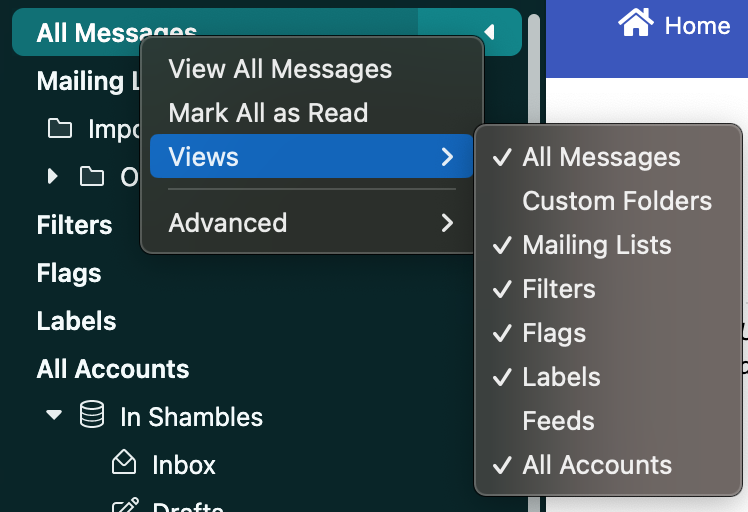
There is a received SUBFOLDER under All Messages that is hidden by default with no indication it exists because the down arrow to expand it is invisible unless you accidentally scroll over it with the mouse. Very odd UI choice, I think.
So this works fine as a unified inbox. I would actually add this to the documentation as a special section, because as it is, the UI is not intuitive at all on this point.
-
@jakedfw said in Add "Inbox" to "All Messages":
There is a received SUBFOLDER under All Messages that is hidden by default
nah, I just tested with a new profile - it's visible by default.
@jakedfw said in Add "Inbox" to "All Messages":
I would actually add this to the documentation as a special section, because as it is, the UI is not intuitive at all on this point.
Already there. https://help.vivaldi.com/mail/mail-get-started/mail-panel/
-
I agree with the OP.
I've only just installed Vivaldi so may be missing something but whilst "Receive" might omit some key folders (such as Sent), it does includes items from many subfolders in addition to Inbox (regardless of the Custom folder setting). So, for instance in my case it includes e-mails in \Inbox and \Inbox\Subfolder.
What most other clients have (emclient, thunderbird etc.) is a folder which only includes e-mails in the Inbox folder of the accounts, and does not include any e-mail from any other folder or subfolders.
[I realise there are those who think folders are a "bad" thing, but imho Vivaldi should be supporting different ways of working rather than forcing people down a particular route]
Matthew
-
@mdovey agreed, Vivaldi should support different workflows, even the inefficient ones

Find your individual accounts with their respective folders in the "all accounts" section of the mail panel. You can show/hide and rearrange the order of the sections in the mail settings
-
@WildEnte thanks but that doesn't address the original request unless I'm missing something.
A more concrete example:
Let use say I have two accounts - Account1 for work and Account2 for personal (this is actually a real scenario I've just anonymized and simplified - in practice there are more accounts and folders...).
Account1 has the following folders: Inbox, Sent, and a subfolder of Inbox called Stuff (perhaps that is where my previous e-mail client archived stuff).
Account2 has the folders: Inbox, Sent, and a Inbox subfolder called Done (again maybe that's how a previous e-mail client worked).
Now if I understand correctly, "All Messages" will display all e-mails from the following accounts/folders:
Account1/Inbox, Account1/Inbox/Stuff, Account1/Sent, Account2/Inbox, Account2/Inbox/Sorted, Account2/Sent
Whereas, Received will display all e-mails from the following accounts/folders:
Account1/Inbox, Account1/Inbox/Stuff, Account2/Inbox, Account2/Inbox/Sorted
What other clients have is a virtual folder "All Inboxes" which displays all the e-mails from just the following account/folders:
Account1/Inbox, Account2/Inbox
It isn't clear how to replicate this behaviour in Vivaldi.
Matthew
-
@mdovey the /stuff/ subfolders are custom folders. Go into received under all messages and above the message list uncheck the "show custom folders" toggle button
-
But that doesn't provide a means of display just the e-mails in Account1/Inbox and Account2/Inbox in a single unified folder.
Matthew
